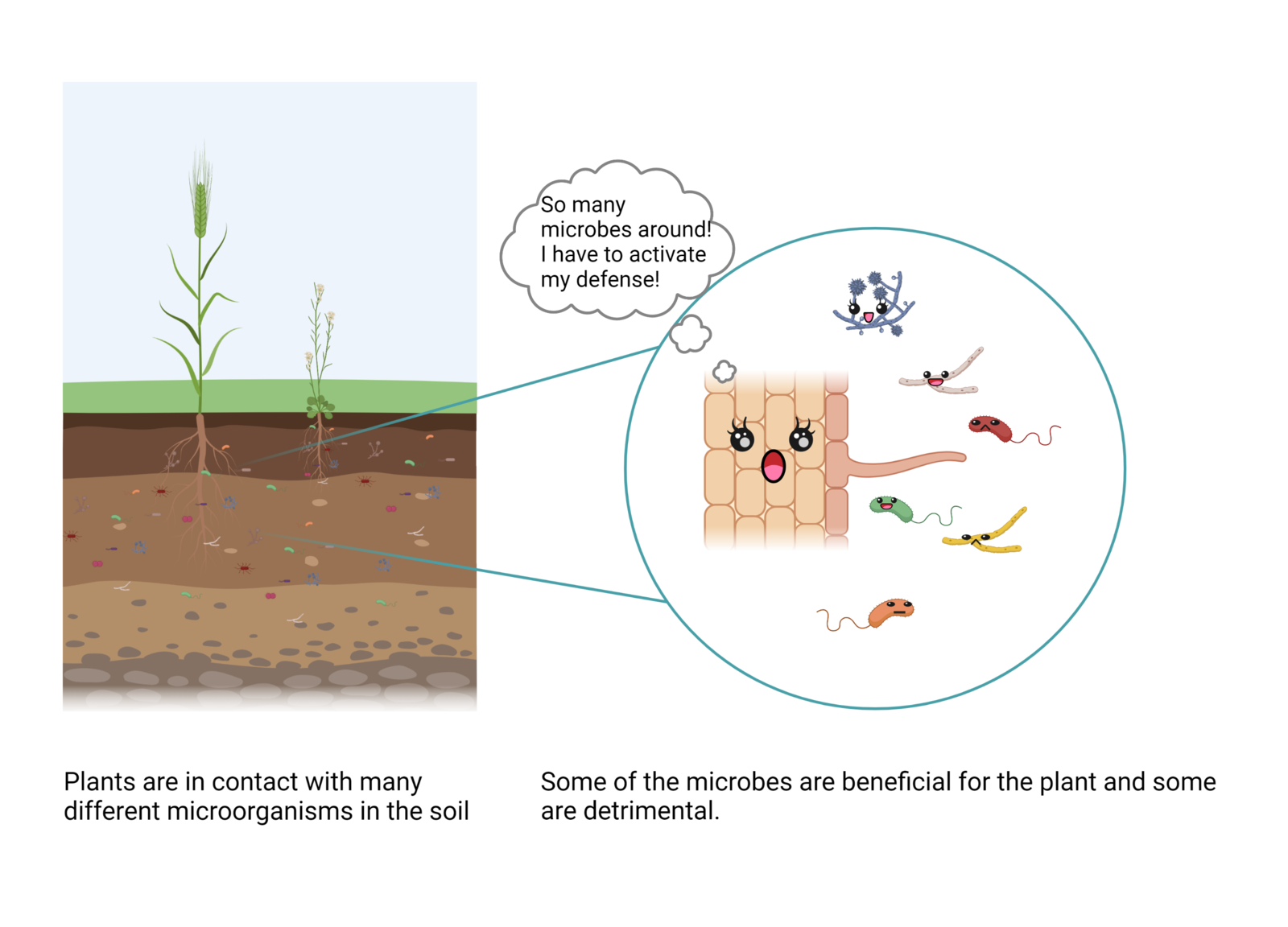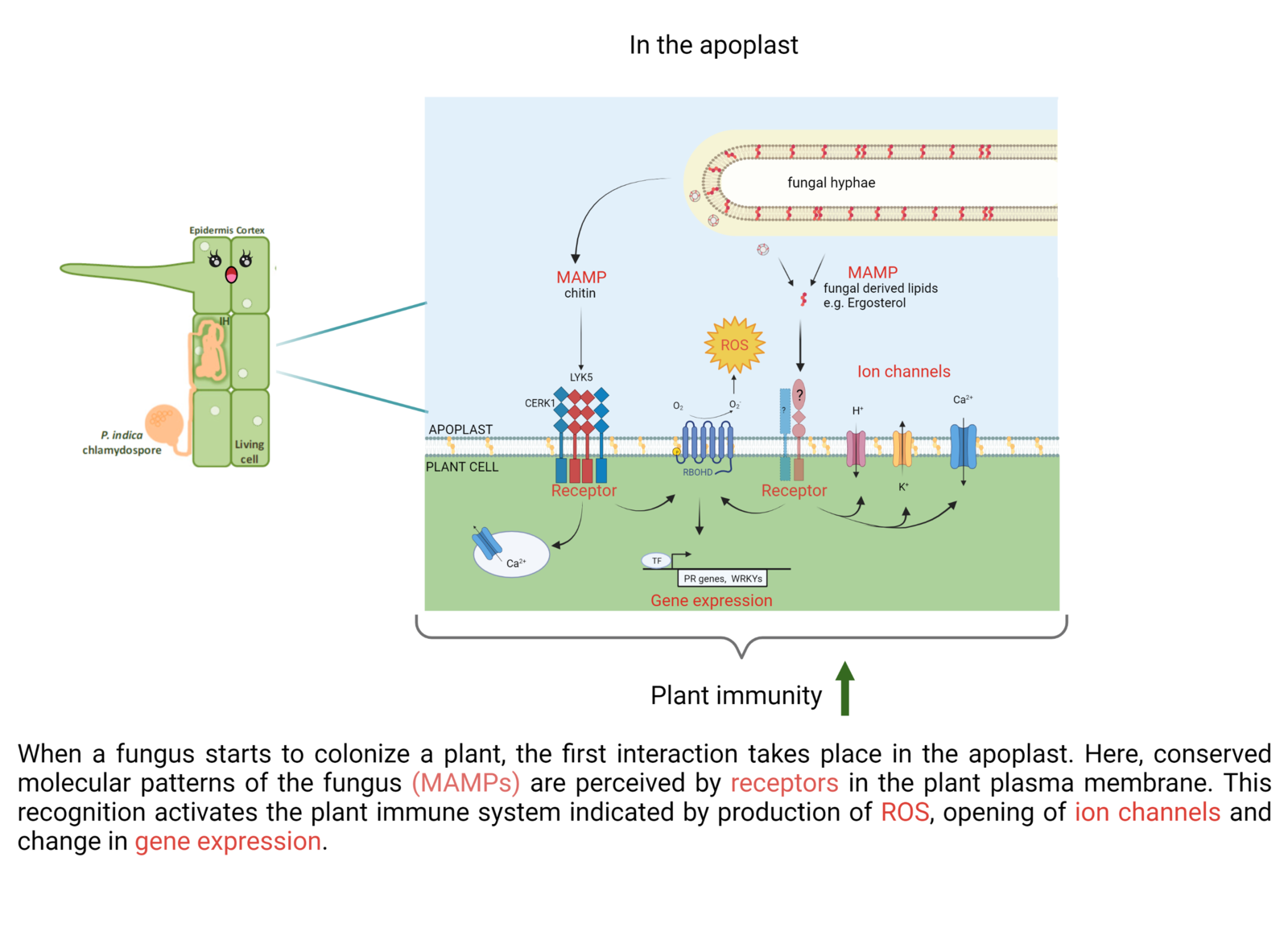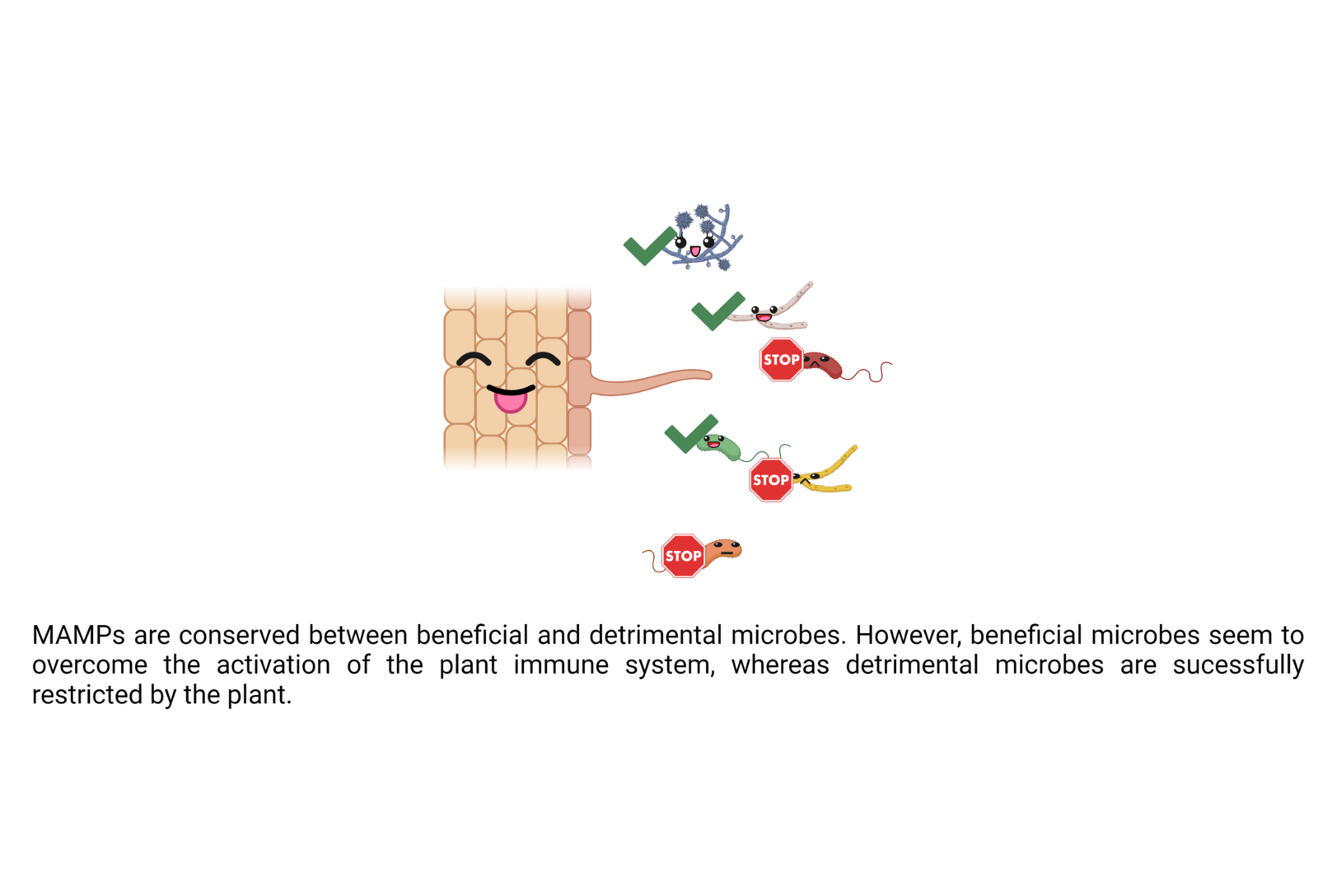Friend or Foe? How can plants distinguish between beneficial and detrimental microorganisms?
Plants stay at the same place for their whole life and can’t simply run away when they are in danger. Therefore, they need a very good immune system to defend themselves against pathogens in the soil or in the air. The immune system of plants is called an innate immune system, in contrast to the adaptive immune system that animals (thereby also us humans) have. However, this does not implicate that the plant’s immune system is in any way worse. Besides mechanical barriers, plants have receptors in their cell membranes, that can perceive so called microbe associated molecular patterns (MAMPs). MAMPs are substances, specific to microbes and absent in plants. In addition, these molecular patterns are mostly conserved in a wide range of microorganisms, therefore can be used as a general recognition system. One example is chitin. Chitin is a sugar that is present in fungal cell walls but absent in plant cell walls. Therefore, using chitin – receptors, plants can sense, that they are in contact with a fungus.
The recognition of MAMPs takes place in the apoplast. The apoplast describes the space that separates the plant cells. Here, microbes and plants interact the first time. The recognition of MAMPs activates the plant immune system. This means, that e.g. channels in the plant membrane that can transport charged particles (ions) are opened to enable ion in- or efflux. Especially for calcium ions, these ion fluxes can induce a rapid signal transduction in the plant cell. Another rapid mechanism is the production of reactive oxygen species (ROS) outside of the cell in the apoplast. Due to their physical and chemical characteristics, ROS can form a toxic environment for microorganisms. In addition, it can function as a signaling molecule and lead to the induction of certain plant genes, that can help the plant to defend itself from invading detrimental microbes. But not all microbes in the soil or in the air are detrimental to the plant. A lot of the microbes, especially in the soil, are beneficial for plants. They can e.g. help the plant to protect itself from detrimental microbes (biotic stress) or survive in harsher climates (abiotic stress) e.g. drought, heat etc. Furthermore, they can simply promote growth of the plants. This is also the case for the fungus Serendipita indica (S. indica), who can colonize many different host plants including the crop barley and the model plant Arabidopsis thaliana. Because of this feature, S. indica is a good candidate to study plant-endophyte interactions. Colonization by S. indica e.g. leads to growth promotion in the host plants as well as protection from pathogens and increased yield. But how can plants distinguish between beneficial and detrimental microbes?
For a long time, research focused on studying the interaction of plants with detrimental fungi and bacteria and how they induce the plants immune systems. But today it is known, that also beneficial fungi and bacteria harbor the molecular patterns that can be recognized by plants. They, however have to overcome this recognition to be able to live together with and even inside the plant for a long time. In my work I am trying to find out, how beneficial microorganisms can colonize the plant without being fended off by the plants immune system. In more detail, I am investigating the role of lipids and lipases (enzymes that cut/degrade/modify lipids) in the interaction of S. indica with Arabidopsis thaliana or barley plants.
In the activation of the plant immune system, MAMPs play a major role. Besides sugars such as chitin or also proteins such as flagellin, also lipids can function as MAMPs. Lipids are the main component of cell membranes and a very broad group of molecules (including e.g. fatty acids, sterols). Besides certain fatty acids of bacteria, also the fungal sterol-lipid ergosterol, which is specifically present in fungal cell membranes, can be recognized as molecular pattern by plants. However, the molecular mechanism of this recognition remains unknown. What is known is that the perception of ergosterol leads to e.g. production of reactive oxygen species, indicating activation of the immune system. Furthermore, it is known that plant- as well as fungal lipases are profoundly produced when the two organisms are in contact with each other. These enzymes can have functions in nutrition of either the plant or the fungus by breaking down lipids and making them accessible. On the other hand, they could degrade or modify e.g. ergosterol or other immune-activating lipids of S. indica, avoiding recognition by the plant. In my PhD, I try to decipher the molecular mechanisms which enable beneficial fungi to colonize their host plants without being recognized and restricted by the plants immune system. Thereby I especially focus on the interaction of lipids and lipases and how their interaction contributes to the establishment of a symbiosis that is beneficial for both partners.
Figures created using Biorender
Planter's Punch
Under the heading Planter’s Punch we present each month one special aspect of the CEPLAS research programme. All contributions are prepared by our young researchers.
About the author

Pia Saake is a PhD student at the University of Cologne at the Institute for Plant Sciences in the group of Prof. Dr. Alga Zuccaro. The group has specialized on studying the interaction of the beneficial endophyte Serendipita indicawith several plants such as barley and Arabidopsis thaliana. Pia focuses on the activation of the plant immune system during this interaction and how the symbiosis between the fungus and the plant can be established. Especially the question which roles lipids and lipases play in the interaction of Serendipita indica with barley and Arabidopsis thaliana fascinates her.
Further Reading
More on lipids in immunity:
Klemptner et al., „Ergosterol, an orphan fungal microbe-associated molecular pattern (MAMP)”, Molecular Plant Pathology, 2014. https://doi.org/10.1111/mpp.12127
More on Sebacinales (S. indica):
Weiss et al., “Sebacinales – one thousand and one interactions with land plants”, New Phytologist, 2016. https://doi.org/10.1111/nph.13977
More on plant immunity:
DeFalco and Zipfel, “Molecular mechanisms of early plant pattern-triggered immune signaling”, Molecular Cell, 2021. https://doi.org/10.1016/j.molcel.2021.07.029


